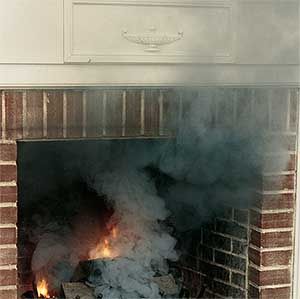
Is your fireplace smoky? Smoke coming into the room, smoke detectors going off?
Well you are certainly not alone and we get this problem quite often. In fact likely half the fireplaces around cause some smoky conditions.
Sometimes it is difficult to get rid of the condition totally. However sometimes there are things that can help.
Is it an older home and you have renovated? Added new windows and doors and perhaps added insulation? You see when smoke or gases from the fire exit the home via the chimney, that air volume needs to be replaced. Older homes had adequate air leaks that this generally was not a problem. However with modern materials we can seal those cracks and hole fairly well and that is when problems begin as that air no longer is able to leak in adequately to meet the need of combustion air replacement. New homes with fireplaces are less prone to this problem as they do have a fresh air intake in the firebox area of the fireplace – ensure you open it when building a fire. And speaking of opening, check up at the top and ensure your damper is fully open – that is the door that opens and closes at the top allowing air and gases to exit into the smoke chamber and chimney area.
The second problem area and one a bit more difficult to fix is the size of the fireplace opening area and depth in relation to the chimney size (area of flue) and total height. This is a critical area that many older fireplace builders simply missed or may not have understood the physics involved and reasons for sizing. The Ontario Building Code details this in a chart today and most new homes are built that work fairly well in this area but I have seen a few which were questionable. The taller the chimney the greater the natural draft so the size or area of flue can actually be smaller for the same air flow. Sadly this is a common one, one that many do not fully understand and one that can cost money to rectify.
A third one may be a fire improperly laid in the fireplace or one using wet wood. I had a customer this past year who had smoky fireplace, I measured the fireplace opening area, depth, chimney height and area of flue and it should work in theory. So they brought some wood and it was green – really green and pine. Not that pine is bad, but it will burn when green.. however will make a whole lot of smoke. It was in this case simply the volume of smoke generated that caused the problem and when I brought them some good, dry, hardwood – it all worked properly.
A forth area is pure physics and environmental in nature. Chimneys are naturally aspirated systems and rely on air pressure and temperature to work properly. Windy days, cold chimneys, etc can actually cause a down draft or back draft into the fireplace from above. Until this is overcome with heat and the draft reversed, the smoke will enter the home. Also outdoor temperature can be a problem – if the indoor air and outside air temperatures are virtually the same then chimney drafts do not work as well – again a matter of physics.
Finally a forth one can be a fireplace which is located in the basement of a home. This is related to air pressure in the home and where the neutral air pressure is relative to the fireplace. The same thing can happen with a basement installed wood stove. Opening a window in the basement a crack when starting a fire will often resolve this problem and is usually an easy one to diagnose. Other mechanical ventilation such as bathroom fan, stove hood fan, etc. can also cause negative pressure and back draft.
One final item but not usually a big concern is the fireplace design, tapered walls and overall design. There is a reason for this design and how it affects the airflow and chimney. If this is a problem it often can be fixed by a mason fairly easily.
And the last one – you may simply have a dirty chimney. No it does not need to be plugged, as creosote builds deposits it creates rough and uneven surfaces. Now it is true that if it is 2mm or thicker it is a serious fire hazard threat, however even less than than can cause air turbulence and air flow resistance thereby reducing draft. You may simply need to get your chimney cleaned.
